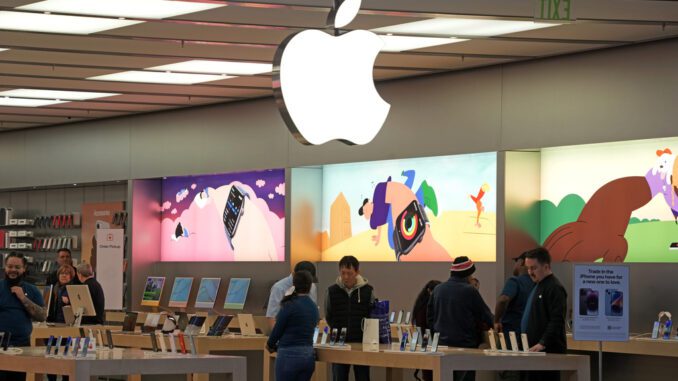
Apple’s eked out a slightly higher profit last quarter even though sales dipped during the period, a showing that may not be enough to sustain investor enthusiasm that recently made the iPhone maker the first publicly held U.S. company to be valued at $3 trillion.
The results released Thursday covered April through June, the third consecutive quarter that the Cupertino, California, company has posted a year-over-year decline in revenue. That’s its longest stretch of falling sales in nearly seven years.
Apple also indicated revenue for the current July through September quarter is expected to decline, despite the anticipated release of the next iPhone. The disappointing forecast, coupled with the lukewarm results for the past quarter, caused Apple’s stock to fall 2% in Thursday’s extended trading.
If the shares behave similarly during Friday’s regular trading session, it will push Apple’s market value below the $3 trillion threshold it eclipsed in late June.
Revenue for Apple’s most recent quarter totaled $81.8 billion, down 1% from last year. Profit edged up 2% from a year ago to $19.9 billion, or $1.26 per share.
“We continue to face an uneven macroeconomic environment,” Apple CEO Tim Cook told investors during the conference call.
The earnings were better than the $1.20 per share projected by analysts polled by FactSet Research, while revenue matched analyst forecasts.
But iPhones sales — the product segment watched most closely by Wall Street — fell 2% from a year ago to $39.7 billion, below analysts’ predictions.
“Investors appear to be reacting to the slight miss in iPhone sales, but I wouldn’t read too much into it as many consumers are holding out until the next iPhone release,” said Investing.com analyst Jesse Cohen.
Investors have remained upbeat about Apple’s prospects despite the company’s modest sales erosion, largely because its results have been less wobbly than other major technology companies that suffered steeper slides coming out of pandemic. Several stalwarts in the sector have announced mass layoffs.
By contrast, Apple has held its ground while still managing to generate eye-popping profits. It has also laid the groundwork for potential growth, recently unveiling a sleek $3,500 headset that many analysts believe will introduce the still-geeky realm of virtual reality to a wider audience.
Apple’s performance capped a succession of mostly positive quarterly reports from Big Tech companies regaining their stride after stumbling through much of year. Tech’s troubles coincided with the pandemic winding down, as people weaned themselves from digital services and products that were in higher demand while they were spending more time at home.
Improving industry conditions have helped lift the tech-driven Nasdaq composite index by 33% so far this year.
But legal efforts to curb Big Tech’s power could pose other obstacles.
Apple is still fighting court rulings that would allow iPhone app makers to provide payment options for digital services outside Apple’s own system, which generates 15% to 30% commissions for the company. Those fees are a lucrative part of Apple’s services division, which generated $21.2 billion in revenue during the past quarter. The battle over that issue will likely be settled by the U.S. Supreme Court, but probably not until next year.
Another key issue for the service division is expected to emerge in a major antitrust case against Google that is scheduled to go to trial Sept. 12 in Washington D.C.
The U.S. Department of Justice and dozens of state attorneys general are trying to prove that Google has been abusing and maintaining its dominance of internet search by forging deals that funnel traffic to it. One of the alliances makes Google the default search engine on the iPhone and other products, for which the company pays Apple an estimated $12 billion to $15 billion annually.



